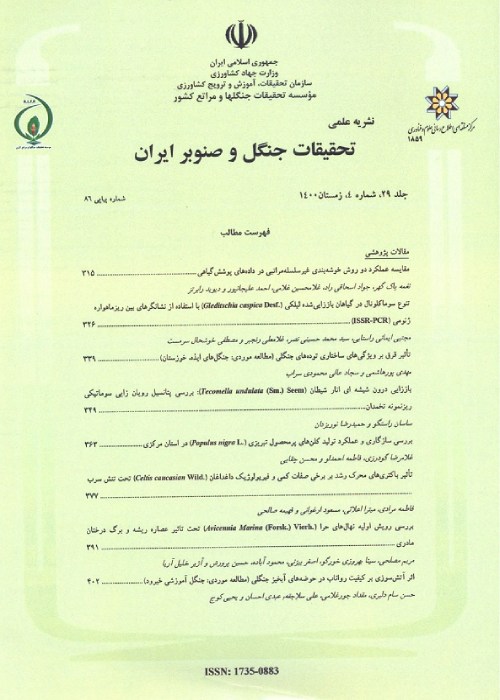Comparison of PCR-RFLP and SSR chloroplast markers in study of genetic structure of beech (Fagus orientalis) populations in Hyrcanian forests
Author(s):
Abstract:
Chloroplast (cp) DNA polymorphism was analyzed in 14 populations of beech (Fagus orientalis Lipsky) by PCR-RFLP and microsatellite (SSR) chloroplast markers. Two cpDNA inter genic regions DT and OA were amplified and treated with HaeIII and HinfI, respectively. The restriction fragments of the region DT did not show polymorphism among individuals within any population analyzed. However, among individuals within the analyzed populations of Asalem region and Neka-1400 population, polymorphism in the restriction fragments of the OA region was found. Three haplotypes, which could be phylogenetically ordered, were detected in this survey encompassing most of the natural range of the species. The high level of genetic differentiation (Gst=%69) together with the highly structured geographic variation contrast with low level of nuclear genetic differentiation measured in previous studies with isozymes and indicate a low level of gene flow by seeds. Among nine analyzed microsatellites, two showed polymorphism. Two and six different length variants at ccmp4 and ccmp7 loci were found, respectively, which combined into 10 different haplotypes. The distribution of haplotypes showed a very strong differentiation among populations (Fst=80%) and clear geographic structure. The analysis of molecular variance (AMOVA) showed that 52, 28 and 20% of the total cpSSR variation was attributable to differences among regions, among populations within regions and within populations, respectively. Clear evidence has been obtained that geographical distance is a major factor of population differentiation in the beech. This long-range pattern of variation was partially expected, given the huge natural range of beech and the existence of a gradient of variation in ecological factors. The high haplotype richness in the western populations, which found by the both markers in this investigation, is in accordance with this hypothesis that the beech forests of the Hyrcanian regions distributed from West to East.
Language:
Persian
Published:
Iranian Journal of Forest and Poplar Research, Volume:14 Issue: 2, 2006
Page:
116
magiran.com/p445102
دانلود و مطالعه متن این مقاله با یکی از روشهای زیر امکان پذیر است:
اشتراک شخصی
با عضویت و پرداخت آنلاین حق اشتراک یکساله به مبلغ 1,390,000ريال میتوانید 70 عنوان مطلب دانلود کنید!
اشتراک سازمانی
به کتابخانه دانشگاه یا محل کار خود پیشنهاد کنید تا اشتراک سازمانی این پایگاه را برای دسترسی نامحدود همه کاربران به متن مطالب تهیه نمایند!
توجه!
- حق عضویت دریافتی صرف حمایت از نشریات عضو و نگهداری، تکمیل و توسعه مگیران میشود.
- پرداخت حق اشتراک و دانلود مقالات اجازه بازنشر آن در سایر رسانههای چاپی و دیجیتال را به کاربر نمیدهد.
In order to view content subscription is required
Personal subscription
Subscribe magiran.com for 70 € euros via PayPal and download 70 articles during a year.
Organization subscription
Please contact us to subscribe your university or library for unlimited access!


